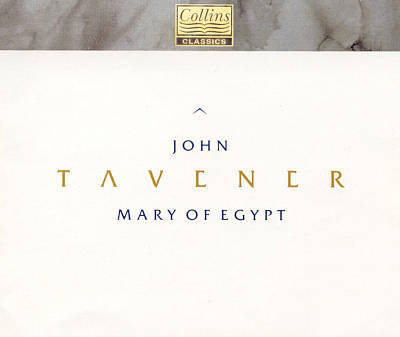Tavener Mary of Egypt
View record and artist detailsRecord and Artist Details
Composer or Director: John Tavener
Genre:
Opera
Label: Collins
Magazine Review Date: 5/1993
Media Format: CD or Download
Media Runtime: 113
Mastering:
DDD
Catalogue Number: 7023-2

Tracks:
| Composition | Artist Credit |
|---|---|
| Mary of Egypt |
John Tavener, Composer
Aldeburgh Festival Ensemble Britten-Pears Chamber Choir Chloe Goodchild, Voice; Mother of God Ely Cathedral Choristers John Tavener, Composer Lionel Friend, Conductor Patricia Rozario, Mary of Egypt, Soprano Stephen Varcoe, Zossima, Bass |
Author: Stephen Johnson
''Mary is like two hours in a warm bath,'' wrote my colleague on The Independent on Sunday. Perhaps, when all the elements of John Tavener's ''living icon''—music, words, gestures, scenery, lighting—are drawn together on the stage, that is what Mary of Egypt is like. For me though, with nothing but the music to sustain the interest, it was more like two hours in an empty bath—not exactly unpleasant, but after a while you begin to wonder if you couldn't be doing something more useful.
In a sense, Mary of Egypt is a tour de force. While The Protecting Veil does move harmonically, if slowly, Mary remains rooted to a pedal F almost throughout—a symbol, says the composer, of the unchanging, unending presence of God. The rare moments where the bass does change—as in the F-G step at the beginning of Mary and Zossima's ''Bless'' duet—seem for a moment enormously significant. No doubt about it—Tavener has an instinct for timing. And you have to admire a composer who can make a line like ''The ways to salvation are more than one'' last four minutes—to say nothing of the singer (Chloe Goodchild) who coaxes and stretches the sounds so effectively.
There are good things in Mary. The rise and fall of the voices' five-note figure in that climactic ''Bless'' duet is appealing in a chaste kind of way—as is the quiet, trilling flute motif that accompanies Mary on her spiritual journey. But there's nothing even approaching the voluptuous beauty of parts of The Protecting Veil; and if there were doubts about the repeatabilty of some of the ideas in that work, how much more so here? The bloom of Mary's flute theme fades after you've heard it for the tenth or eleventh time—shifting the mode from major to minor doesn't quite revive it. Other ideas— Zossima's dissonant trombone stabs, or the Swine People's moronic one-note chant—pall much more quickly.
Tavener can write effectively for voices though, and Patricia Rozario delivers Mary's long chromatic plaints elegantly and expressively. Stephen Varcoe's Zossima too reveals real human passion in his self-tormenting monologues. The orchestra and choruses under Lionel Friend sing and play with authority, and the recordings would be impressive even if they hadn't been made at a live production. The ''exclusive interview'' with Tavener on the second disc doesn't actually contain a lot that he hasn't said elsewhere, but it does make a useful supplement to the booklet for newcomers to Tavener. But then, if you are new to Tavener and are looking for a place to start I wouldn't recommend this.'
In a sense, Mary of Egypt is a tour de force. While The Protecting Veil does move harmonically, if slowly, Mary remains rooted to a pedal F almost throughout—a symbol, says the composer, of the unchanging, unending presence of God. The rare moments where the bass does change—as in the F-G step at the beginning of Mary and Zossima's ''Bless'' duet—seem for a moment enormously significant. No doubt about it—Tavener has an instinct for timing. And you have to admire a composer who can make a line like ''The ways to salvation are more than one'' last four minutes—to say nothing of the singer (Chloe Goodchild) who coaxes and stretches the sounds so effectively.
There are good things in Mary. The rise and fall of the voices' five-note figure in that climactic ''Bless'' duet is appealing in a chaste kind of way—as is the quiet, trilling flute motif that accompanies Mary on her spiritual journey. But there's nothing even approaching the voluptuous beauty of parts of The Protecting Veil; and if there were doubts about the repeatabilty of some of the ideas in that work, how much more so here? The bloom of Mary's flute theme fades after you've heard it for the tenth or eleventh time—shifting the mode from major to minor doesn't quite revive it. Other ideas— Zossima's dissonant trombone stabs, or the Swine People's moronic one-note chant—pall much more quickly.
Tavener can write effectively for voices though, and Patricia Rozario delivers Mary's long chromatic plaints elegantly and expressively. Stephen Varcoe's Zossima too reveals real human passion in his self-tormenting monologues. The orchestra and choruses under Lionel Friend sing and play with authority, and the recordings would be impressive even if they hadn't been made at a live production. The ''exclusive interview'' with Tavener on the second disc doesn't actually contain a lot that he hasn't said elsewhere, but it does make a useful supplement to the booklet for newcomers to Tavener. But then, if you are new to Tavener and are looking for a place to start I wouldn't recommend this.'
Discover the world's largest classical music catalogue with Presto Music.

Gramophone Digital Club
- Digital Edition
- Digital Archive
- Reviews Database
- Full website access
From £8.75 / month
Subscribe
Gramophone Full Club
- Print Edition
- Digital Edition
- Digital Archive
- Reviews Database
- Full website access
From £11.00 / month
Subscribe
If you are a library, university or other organisation that would be interested in an institutional subscription to Gramophone please click here for further information.




